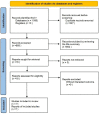Risk of dementia or cognitive impairment in non-alcoholic fatty liver disease: A systematic review and meta-analysis
- PMID: 36204558
- PMCID: PMC9530447
- DOI: 10.3389/fnagi.2022.985109
Risk of dementia or cognitive impairment in non-alcoholic fatty liver disease: A systematic review and meta-analysis
Abstract
Objectives: To investigate whether non-alcoholic fatty liver disease (NAFLD) increases the risk of dementia or cognitive impairment.
Methods: A systematic search of the literature in the PubMed, Excerpta Medica Database (EMBASE), Cochrane Library, and Web of Science databases was conducted, covering the period from the inception of each database to 22 May 2022. Statistical analysis of non-alcoholic fatty liver disease and the risk of cognitive impairment or dementia based on data extracted from each article was performed using Stata software v. 16.0. The quality of this study was assessed using the Newcastle-Ottawa Scale (NOS) for assessing the quality of cohort and case-control studies and the American Agency for Healthcare Research and Quality (AHRQ) methodology checklist for assessing the quality of cross-sectional studies. Funnel plots and the Egger's test were used to assess publication bias.
Results: We included 7 studies comprising 891,562 individuals from 6 countries, which were published between 2020 and 2022. The pooling analysis showed that a history of NAFLD was associated with cognitive impairment [odds ratio (OR) = 1.44; 95% CI: 1.17-1.78; heterogeneity (I 2) = 0%; P = 0.001]. A history of NAFLD was not associated with an increased risk of all-cause dementia (OR = 1.03; 95% CI: 0.97-1.09; I 2 = 84.7%; P = 0.341) or Alzheimer disease (OR = 0.95; 95% CI: 0.83-1.09; I 2 = 61.0%; P = 0.489). In contrast, NAFLD was associated with an obvious reduction of the risk of vascular dementia (OR = 0.88; 95% CI: 0.79-0.98; I 2 = 0.0%; P = 0.020). In the subgroup analysis, male and female patients with NAFLD showed an equal risk of dementia or cognitive impairment. The risk of dementia or cognitive impairment in the cross-sectional study (OR = 1.49; 95% CI: 1.19-1.88; I 2 = 0.0%; P = 0.001) was slightly higher than that in the retrospective cohort (OR = 1.03; 95% CI: 0.97-1.09; I 2 = 84.3%; P = 0.294).
Conclusions: NAFLD was associated with an increased risk of cognitive impairment and a decreased risk of vascular dementia. More studies are needed to clarify the pathophysiological mechanism underlying the association between NAFLD and dementia or cognitive impairment.
Systematic review registration: https://www.crd.york.ac.uk/prospero/#recordDetails, identifier: CRD42022334492.
Keywords: Alzheimer's disease; NAFLD; cognitive impairment; dementia; meta-analysis; non-alcoholic fatty liver disease; systematic review; vascular dementia.
Copyright © 2022 Wang, Sang and Zheng.
Conflict of interest statement
The authors declare that the research was conducted in the absence of any commercial or financial relationships that could be construed as a potential conflict of interest.
Figures






Similar articles
-
Gout and risk of dementia, Alzheimer's disease or vascular dementia: a meta-epidemiology study.Front Aging Neurosci. 2023 Apr 26;15:1051809. doi: 10.3389/fnagi.2023.1051809. eCollection 2023. Front Aging Neurosci. 2023. PMID: 37181628 Free PMC article.
-
Risk of Dementia or Cognitive Impairment in Sepsis Survivals: A Systematic Review and Meta-Analysis.Front Aging Neurosci. 2022 Mar 9;14:839472. doi: 10.3389/fnagi.2022.839472. eCollection 2022. Front Aging Neurosci. 2022. PMID: 35356300 Free PMC article.
-
Risk of dementia or cognitive impairment in COPD patients: A meta-analysis of cohort studies.Front Aging Neurosci. 2022 Sep 9;14:962562. doi: 10.3389/fnagi.2022.962562. eCollection 2022. Front Aging Neurosci. 2022. PMID: 36158542 Free PMC article.
-
Association between grip strength and non-alcoholic fatty liver disease: A systematic review and meta-analysis.Front Med (Lausanne). 2022 Aug 26;9:988566. doi: 10.3389/fmed.2022.988566. eCollection 2022. Front Med (Lausanne). 2022. PMID: 36091710 Free PMC article.
-
Schizophrenia and type 2 diabetes risk: a systematic review and meta-analysis.Front Endocrinol (Lausanne). 2024 Sep 11;15:1395771. doi: 10.3389/fendo.2024.1395771. eCollection 2024. Front Endocrinol (Lausanne). 2024. PMID: 39324122 Free PMC article.
Cited by
-
Bidirectional association between breast cancer and dementia: a systematic review and meta-analysis of observational studies.PeerJ. 2025 Jan 31;13:e18888. doi: 10.7717/peerj.18888. eCollection 2025. PeerJ. 2025. PMID: 39902325 Free PMC article.
-
Impact of insulin resistance on mild cognitive impairment in type 2 diabetes mellitus patients with non-alcoholic fatty liver disease.Diabetol Metab Syndr. 2023 Nov 10;15(1):229. doi: 10.1186/s13098-023-01211-w. Diabetol Metab Syndr. 2023. PMID: 37950317 Free PMC article.
-
Metabolic-dysfunction associated steatotic liver disease-related diseases, cognition and dementia: A two-sample mendelian randomization study.PLoS One. 2024 Feb 29;19(2):e0297883. doi: 10.1371/journal.pone.0297883. eCollection 2024. PLoS One. 2024. PMID: 38422093 Free PMC article.
-
MAFLD as part of systemic metabolic dysregulation.Hepatol Int. 2024 Oct;18(Suppl 2):834-847. doi: 10.1007/s12072-024-10660-y. Epub 2024 Apr 9. Hepatol Int. 2024. PMID: 38594474 Review.
-
A Possible Reversible Cause of Cognitive Impairment: Undiagnosed Cirrhosis and Potential Hepatic Encephalopathy in Patients with Dementia.Am J Med. 2024 Nov;137(11):1082-1087.e1. doi: 10.1016/j.amjmed.2024.06.014. Epub 2024 Jun 26. Am J Med. 2024. PMID: 38942345
References
Publication types
LinkOut - more resources
Full Text Sources

